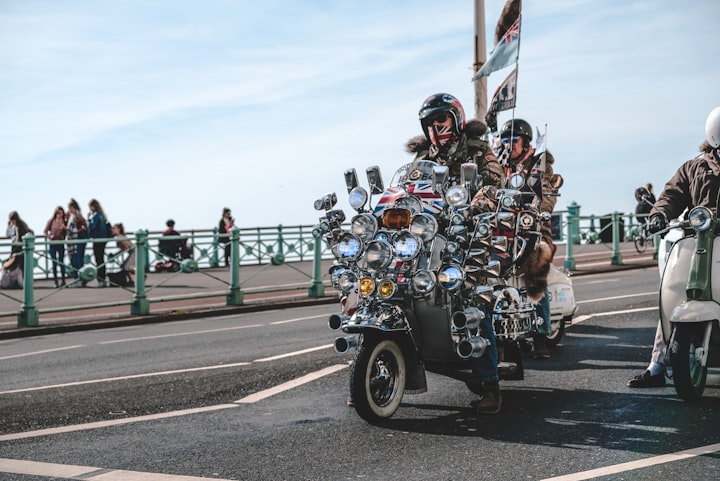
The year was 1965, I was thirteen years old and I opened the box as though I were opening a chest full of jewels, Inside the thin layer of cardboard and hidden beneath a mountain of tissue paper were my first pair of Chelsea boots This was to be the first stage of my becoming a Mod (short for modernist) At the school I attended you were either a Beatles (Mod) fan, or a Rolling Stones (Rocker) fan, even though the Stones would early in their careers opt for the mod look, the point was that there was no in-between, you were what you wore when you clambered out of your school uniform and hit the streets. I opted for the mod look, even though I was a massive Stones fan.
There wasn’t much footwear selection for the new mod to wear, but it didn’t bother me, it was all about what was above that really mattered, I could have chosen Desert boots which were also known as Chukka boots which had a short lace-up panel and are still very popular today. But I preferred the Chelsea boot, (the choice of the Beatles but with a Cuban heel added) I liked the elasticated side panel because like most youths, I was basically lazy, and these boots slid on and off with great ease. The other reason for this choice was that they looked as good with suits as they did with jeans or chinos.
Chelsea Boots have never really gone away from fashion, but over the last couple of years they have been making a comeback, But, we have to go back over a 170-years to 1840 and the reign of Queen Victoria to discover the beginnings of the boot. At that time there was an official bootmaker to the Queen who is now given credit for the creation of the boot, J Sparkes-Hall used a comparatively new substance called vulcanised rubber which boasted a lot more movement, and flexibility, he said that the Queen ‘walked in them daily’ and that she endorsed them. These boots were initially designed for horse riding and became known as ‘Paddock Boots’. They were popular up to the outbreak of World war One in 1914 but fell out of favour until they were redefined in the late fifties.
I digress, those boots in 1965 cost me over 16 weeks of delivering newspapers in all weathers, but although most of my friends admired my choice, I was nowhere near becoming a mod.
The modernist look was actually created from both the Teddy Boys and the Beatniks of the time. The Teddy boys were the presentable clean cut and elegant side, whilst the beatniks offered the darker side of fashion, but put together with a few adjustments and the mod look was born.
My next item of clothing for my transformation wasn’t going to cost me anything like the price of my boots, but it would make a big change from the shirt and tie I normally wore, it was the humble roller neck shirt (also popularised by the Beatles) otherwise known as turtlenecks. These had to be one colour to be authentic, sometimes – but rarely – a thin pin stripe would be acceptable. Not only should they be one colour, but it should be a dark colour, the classic of course would be Black. They were easy to wear under a jacket or even a suit coat, I was well out of order when I wore mine beneath a terrible brown corduroy jacket.
But the very foundation of mod style had to be the polo shirt, still worn today by millions of men all over the world, like todays male, the mod of the mid-sixties found this item of clothing the most versatile of all his choices in his wardrobe. Once again it had to be block colour, with preferably no logos on show, back then, the real style for a true mod was to have the shirt buttons ‘all the way’ up.
As I was gathering my complete ‘mod look’ I managed to get a weekend job in a local scrap yard, I was paid four times more for one day than I was paid for delivering papers in the snow, rain and sleet, there were no more 6am starts and late arrivals at school, just weekends of work which I really enjoyed. This of course would allow me to spend a lot more money on keeping up with the constantly evolving fashions of the mid-sixties’ mod.
So, my next big purchase was going to be trousers, classic Levi jeans or Chinos. Unlike the terrible baggy denim blue jeans my dear old dad wore for work these items were sharp, clean cut and well fitted, not like todays ‘skinny’ fit, but well -tailored straight or tapered cut styles. I suppose the basic rule was that if they looked good and fitted comfortably then they were acceptable. Just one more thing, the bottom of the trouser had to be ‘turned back’ to show off the classy footwear beneath it.
And so, we come to the garment that would complete my look, the jacket, this is where I initially fell down badly, my corduroy jacket just didn’t cut it, no matter what I was wearing below and underneath that jacket ruined it. The elderly professors at my college were wearing the same sort of jacket in 19678. It had to go, what I needed was a real mod jacket, A Harrington jacket (originally known only as a Baracuta jacket or a G9) was a lightweight, waist-length jacket made of cotton, polyester, wool, or suede. Designs back then often incorporated traditional Fraser tartan or checkerboard-patterned lining. You’ve probably never heard of this jacket, well, neither had I, but I was influenced by the waist length jackets worn by the stars of the time, stars like James Dean, But Steve McQueen (Who, uncannily, my wife has been in love with all her life) wore it most memorably, with t-shirts, jeans, and boots.
The number one and still the best jacket is the classic Fred Perry Harrington jacket, it has been remastered and reissued for the 21st-century male. Fred Perry has lovingly re-introduced the brand's most celebrated styles and designs from its archives, dating all the way back to the 60s. A true iconic 60’s mod jacket should not only be functional and stylish, but be versatile as well, it should ideally be waist-length, lightweight, and have a standing collar, and should always have a bold tartan plaid lining. This is the only part of a mods make up that there were no rules on as to colour, it was an almost ‘anything goes’ item, as long as it had the correct styling. The jacket in short epitomised and completed the mod look of the sixties.
Finally, there was alternative to most of the aforementioned, it was the suit, John Collier and Burton’s window displays were full of smart suits in brown, grey or charcoal, Men were – mostly – still walking around in the drab suits which had been inherited from the post war years, but the mod look changed all that. We wanted something sleeker, something tailored, a better slimline fitting suit, with eye-catching linings; three button fastening; side vents; Ticket pockets; Button detailing, like buttons covered in the same material; We wanted notched lapels and slim silhouette. And that, was eventually what we got, within a matter of months Burtons and John Colllier all had shop windows full of mod suits. They could be worn with Turtlenecks Polo shirts or traditional shirt and tie, their secret was that they were modern. If you were to purchase a mod suit today, the style would include two buttons, slightly wider lapels, and pared-down gold hardware.
Sadly, by the time I married in 1973 Mods were a distant memory, they had given way to flower power, hippies, and drugs, but there were still lots of Italian Vesta’s and Lambrettas, and regular meetings of staunch mods in green fur-lined fishtail Parka coats.
In the mid to late 70’s Punk rock was the thing, but from the Sex Pistols outrageous outbursts on TV to their ban from Top of the Pops it was obvious that the Punk Culture was going nowhere, there was nowhere for them to go after the initial shocking appearance.
But then in 1977 a band formed in 1972 spearheaded the mod revival, Paul Weller’s Jam hit the charts quietly but by the start of the eighties they were making regular appearances on Top of the Pops dressed in their smart tailor cut suits. Other Mod revival groups of the time were The Lambrettas; Secret Affair; · The White Trainers Community; The Chords; Purple Hearts; Squire and The Merton Parkas to name but a few.
In 1979 the film Quadrophenia enhanced the return of Modernist tendencies. It was helped along by the original mod revival fanzine, Maximum Speed started in 1979, which also spawned other home-produced fanzines from then until the mid-to-late 1980s.
In the late 90’s the Mod look was championed once again, this time the boost came courtesy of Oasis and more particularly, Liam Gallagher, their rivals Blur also played their part in the revival.
Teddy Boys, Punks, skinheads, suede heads, the Mod has outlasted them all.
There is no other style in British history that has stood the test of time like the mod style and culture, though many have tried. The mods remain stylish because they always were.
But I regret to say that today’s youth are not – or at least don’t appear to be into formal dress, suits are still purchased of course, but only for special occasions like weddings, christenings and funerals, the humble suit has become a mark of respect and most wardrobes only boast one.
But, having said that, the Mod look is long overdue it’s next appearance on the streets.
About the Creator
Eric Harvey
I am a grandfather of four and a father of four, I am 69 years old and i live in Kidderminster , Worcestershire in the heart of England. I have been happily married for 48 years.We lost our youngest daughter Vickie to Leukemia 7 years ago.






Comments
There are no comments for this story
Be the first to respond and start the conversation.